
If you read any of the autobiographies of the great climbers of the 1970s, 80s and 90s you’ll note that climbing used to be a fairly perilous niche activity to get into.
Information was sparse, gear was limited, and mistakes were painful. Those tales stand in stark contrast to today, where climbing has never been more accessible or mainstream.
Climbing is an Olympic sport, more people are climbing indoors than ever, the barrier to entry is lower, and facilities are bigger, better and more proliferate.
Join author, writer, photographer and gritstone aficionado (+ protector!) Dave Parry as we explore ways in which anyone who takes their climbing outdoors can
Stay Classy
Watch Video
Intro
So in light of the boom in participation what does responsible and sustainable outdoor bouldering look like in the future? Given we can’t build new crags, rock is a finite commodity, so we have to look after what we’ve got.
What is best practice, what’s the baseline of good behaviour we should all expect, and how do we ensure outdoor bouldering in the UK has a sustainable future?
These questions were in my mind when I wrote Grit Blocs, so I made a real effort to include some of Gritstone’s unsung gems, off the beaten-track lines. That’s only part of the bigger picture though.
Gritstone is not the only rock type out there, but it serves as the de-facto local rock for the huge population centres of the North, and one with particular vulnerabilities in terms of bad practice.
Devotees of the sandstone of Cheshire, Northumberland and Staffordshire will be aware of issues around the fragility of rock, but you can still take away plenty from this if you live near limestone crags, or the mountain rock of the Lakes or Wales, or even further afield.
Increased climbing participation undoubtedly makes for good business for climbing brands, but with this comes a moral obligation of mentorship and to steer new outdoor climbers in the right direction.
With that in mind, it’s been great to work with Depot Climbing to try and provide a few pointers on how to Stay Classy when taking your climbing into the big and exciting outdoor world.
The beautiful environments in which we enjoy our unique pursuit
Image: Dave Parry
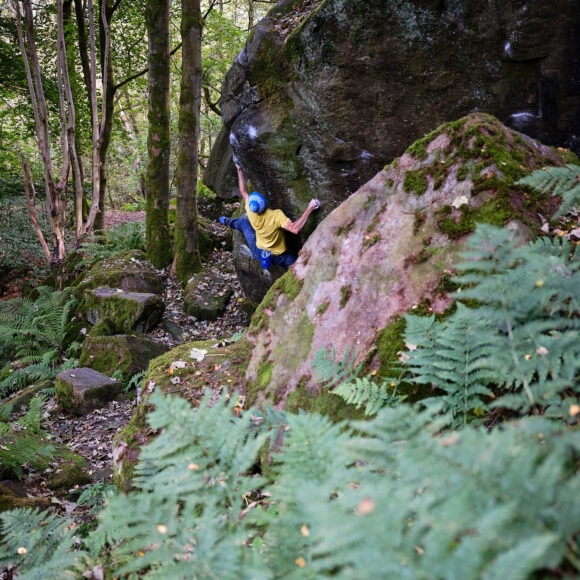

Custodianship
It’s often said that indoor climbing and outdoor climbing today are two different activities. They share the same genesis, and a common language of movement, and much has been made of how different styles of climbing have emerged in the modern era.
But beyond this one of the oft-overlooked differences between indoor and outdoor climbing is custodianship.
When you climb indoors your relationship with the space is a transactional one, of a customer. Part of what you pay at the front desk goes towards upkeep. So the wall staff clean up, replace the holds, vacuum the pads, keep the coffee machine running and clean the toilets.
But outdoor crags are not just a facility that someone else looks after, WE are responsible for the upkeep.
Even in outdoor spaces which are actively managed by landowners for recreation, the finer details of the climbing environment – the boulders, the holds, the landings – are rarely considered significant enough to be a priority.
So that means you, me, all of us, whether we are a local or a visitor, we all have a shared responsibility.
Some issues are pretty clear cut; litter. We can all get behind this pretty easily. Just take everything home that you came out with, including discarded finger tape.
‘Leave only footprints’ as the old saying goes.
Even better, it’s not too much of a trial to stick an empty bin liner or old stuff sack in your crag bag to pick up any litter you find. Sadly not all outdoor users are as considerate as climbers, and stumbling upon a discarded beer or worse, can, isn’t a rare occurrence.
Being astute about litter is also a great way to set an example to other outdoor users, and gives all of us climbers a chance to be viewed in our best light – it’s an easy win.
But from a purely selfish point of view the single biggest thing any of us can do to be good custodians of gritstone boulder problems, the single most pressing issue to address, is to
Only climb on completely dry rock.
We’re increasingly seeing the damage and accelerated wear on gritstone boulders due to totally avoidable bad practices around wet rock.
Unfortunately in some circles, the single-minded pursuit of projects, or maybe the kudos of the success-against-the-odds narrative on social media, is too strong to resist, and some of us insist on trying boulder problems which are not dry.
Gritstone, like sandstone, is incredibly fragile when wet.
We climb on a sort of thin crust on top of softer rock, that outer crust – or ‘patina’ – being created by chemical reaction with the environment over thousands and thousands of years.
Once that outer layer is compromised or broken then holds will just grind away every time they are brushed, grabbed or stood on, and quickly become a deteriorating mess.
For the avoidance of doubt, the word ‘wet’ here doesn’t just mean dripping wet, ‘wet’ also covers ‘damp’, ‘a bit soapy’, and ‘kinda feels a bit gopping mate but should be fine with some chalk on it’. We need to raise our game here because
Dry enough to do the moves with a ton of chalk on isn’t dry enough to not be damaged
and that critical grey area is where the danger lies. If there’s any doubt in your mind as to whether something is dry or not then, well, it probably isn’t dry.
The only answer is to come back later, even if that means returning on a better day. It’s fine to walk away, it’s okay to go home empty-handed, that’s just part of the game of outdoor climbing, and part of our job as crag custodians.
The sad fact is on certain boulders just one person breaking a damp crimp, or heelhooking on a wet sloper, no matter how much chalk they’ve covered it in, can set in motion an irreversible path to ruin.
Unfortunately, certain key popular venues, such as Stanage Plantation, have gained a sometimes undeserved reputation as being universally fast to dry after rain.
Many grit crags can undoubtedly dry in minutes on breezy days after a quick rain shower, but even ‘quick drying’ crags still have some slow-drying boulders lurking.
In the dark depths of winter, on those grim January days where it’s been raining every day for a week and daylight hours are scarce, things certainly do not necessarily dry fast. All too often rock can be just superficially dry on the surface, with dampness remaining inside.
Yet on such a winter’s day, you can walk up to the Plantation and invariably find rock-starved eager climbers dutifully scrubbing chalk into the slopers of various problems trying to dry them out, which brings us neatly on to our next point…
Clear Signs of Erosion and Damage on the starting ledge of the Stanage classic, Crescent Arete
Image: Dave Parry
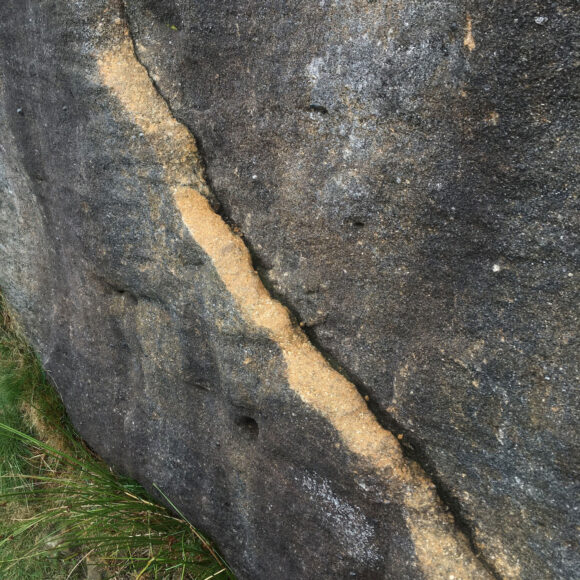

Cleaning chalk after climbing is good practice and helps keep the longevity of our beloved boulders
Image: Dave Parry
Watch Stay Classy Video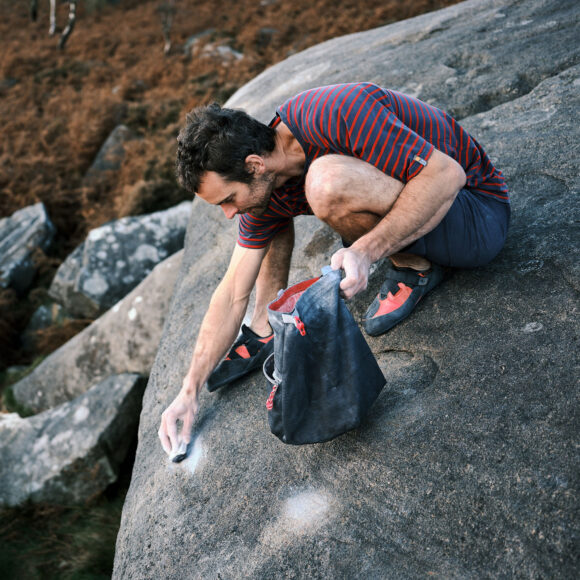

Chalk
We need to be mindful that the chalk we use for climbing – magnesium carbonate – is not a benign substance.
This is another key difference between indoor and outdoor climbing. Indoors it just means the holds need cleaning when they get reset, and it’s another consumable to buy in the shop.
When used outdoors chalk will over time kill surface lichen in the rock, leaving bleached-looking stripes below holds where rain washes it down.
When heavily caked onto holds chalk fills in the texture of the rock, spoils the friction, and even after rain might not totally be removed.
Where the rock never receives heavy rainfall directly – under roofs or in pockets and breaks – it never washes off at all. On such holds that retain chalk over time, chalk can turn into a sort of slow-drying paste in damp weather, which in turn takes even longer to dry.
And when people cake chalk onto wet rock to try and dry it out we end up with huge swathes of painted-on-looking white areas. It’s ugly and it does nobody any favours.
The other contentious aspect of chalk use, and a pet hate for many climbers, comes in the form of the chalk lines drawn on the rock to indicate where holds are.
Tickmarks are – by design – very visually jarring.
Often once a tick mark is made on clean dark rough grit it’s actually quite hard to fully remove unless you wet your brush first, which a lot of people don’t seem to do anyway.
So what can we do, what does responsible chalk use look like?
Most of us would prefer to not encounter problems which are heavily chalked and covered in tickmarks, so as a basic courtesy to the next person you should
always brush as much chalk off as possible after climbing a problem – think of it as the climbing equivalent of flushing the toilet.
A nice soft brush is just the thing for gritstone, and it’s a great way of passing time between attempts on that project. If we can get into the routine of brushing off our chalk before we move on to the next boulder then that’s ideal.
Just be careful when selecting a brush, as the perfect brush for hard mountain rock might be too stiff and damage grit or sandstone.
If you must use tickmarks, be as sparing as you can – a small unobtrusive dab of chalk will often do the job. Habitually marking ALL handholds with tickmarks is completely unnecessary and a practice to be heartily discouraged.
If you can step away from climbing-by-the-numbers tickmark habits then it’ll probably do your climbing good in the long term.
The gold standard should always be to not use tickmarks at all, because then there’s no chance you’ll forget to remove them, solving the problem before it happens.
Similarly, we can take steps to pre-empt general chalk overuse. Simply filling up with less chalk in our chalk bags and boulder buckets can help to remove the temptation to use too much. Plus then when your friend accidentally kicks your bag over you don’t lose twenty quids worth of Friction Labs’ finest on the floor.
Also, the various liquid chalk products on offer are worth looking into. They may not replace loose chalk but should mean you need to use less of it. Most of us would probably be happy to not use chalk at all if there were an equally effective and less visually intrusive alternative.
That seems a way off yet, so we’re probably stuck with the white stuff for the time being.
Example of bleached-looking stripes left behind from chalk use where rain has washed excess chalk down the rock
Image: Dave Parry
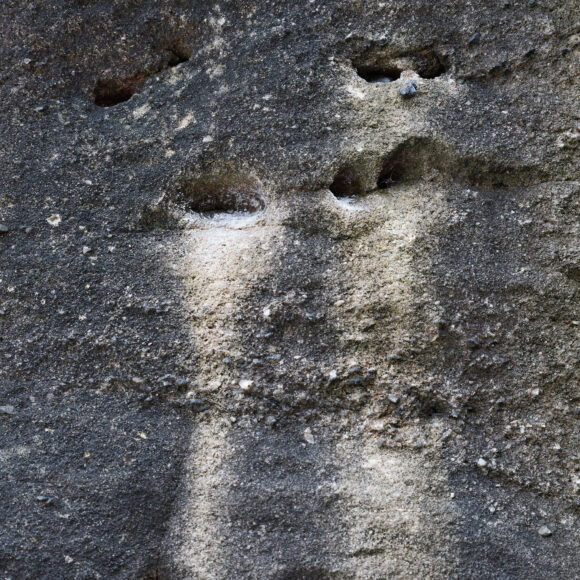

Non-climbers also enjoy and utilise the outdoor spaces we love
Image: Dave Parry
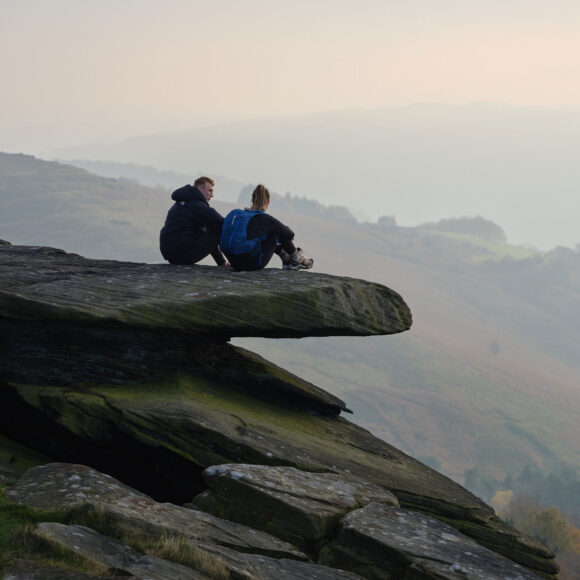

Courtesy
Brushing off our chalk is a great courtesy to our fellow climbers, as is making sure our climbing shoes are clean before we climb, and has the added bonus of preventing erosion on footholds. But what about courtesy to other outdoor users, how do we give the best possible impression of ourselves?
Of course, all the usual Countryside Code stuff still applies when out climbing – closing all gates, taking care when crossing stiles or walls, keeping dogs on leads where required etc, and being vigilant about the fire risk during our increasingly hot and dry summers – so that means no sources of ignition on the moors, no fires, and especially:
No disposable BBQs
But the wider thrust of this ethos is that we can enjoy the outdoors and the countryside in a way which doesn’t prevent other people from enjoying their day out too.
For example one of the great draws of the outdoors is the quiet and the escape from the relentless noise and bustle of urban living. Virtually nobody going out into the countryside appreciates hearing someone else’s music playing, so it should go without saying that playing music at the crag is an absolute no-no.
Headphones were invented for a reason after all.
It doesn’t really matter if you think there’s nobody else around, because anyone approaching will probably hear your music before you can see them, by which point the damage to all climbers’ reputations is done.
Similarly, most other people probably don’t want to hear you shouting and swearing when you fall off the last move of your project on the 500th attempt. It’s tough when you’ve invested a lot emotionally into climbing, as most of us have, but such outbursts rarely endear climbers to the general public.
That relationship between climbers and non-climbers is often crucial when access issues arise.
There have been cases over the years where we’ve lost access to crags due to the poor behaviour of members of our own community. And once access is lost it’s often an uphill struggle to get it back.
Sadly access can never be taken for granted or assumed, so it’s good to get into the habit of checking on the current access advice for any venue before you visit, watch out for and respect any temporary restrictions (for example to protect nesting birds), and in general be polite to anyone questioning your presence.
As always the first port of call to check access is the BMC RAD database, and report any emerging issues to your local BMC Access Rep.
Wilton 3 Quarry in Lancashire a unique example of shared access between climbers and the local gun club
Image: Dave Parry
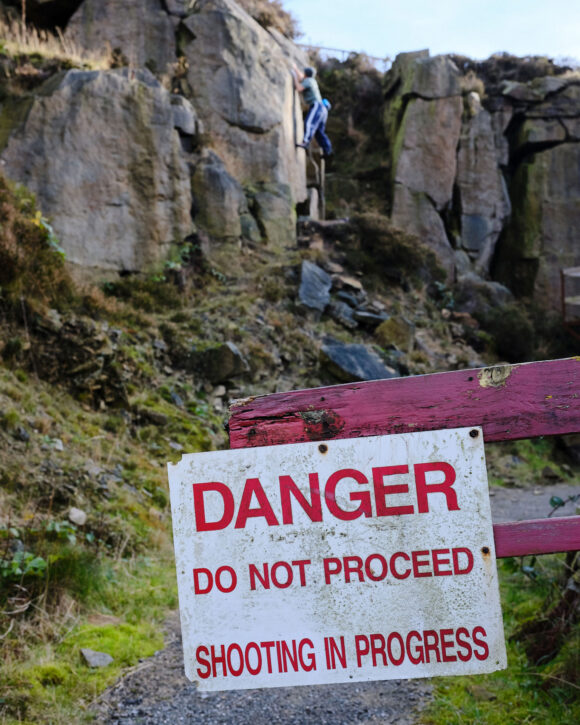

Cars
The issue of car access to the outdoors is still problematic. Even if we can hopefully consign to history the COVID-related spectacle of everyone driving out in separate cars.
Parking remains contentious at many venues.
In the worst cases it potentially pits climbers, walkers and cyclists against local residents, farmers and emergency services. And there’s the wider issue of climate change and fossil fuel use.
Whilst it’s beyond the power of climbers individually to solve these problems, we can certainly all take steps in the right direction.
We can make sure we’re parking responsibly and legally, and on busy days we can think about going somewhere more esoteric away from honeypots.
We can drive carefully, particularly around other users and livestock (pro tip – sheep don’t understand what a beeping horn means).
Car-sharing is great for both parking and environmental reasons.
Sadly a comprehensive and reasonably priced public transport alternative isn’t likely to appear overnight, but it’s worth considering if you can make the odd bus or train-based climbing trip now and again.
Close to cities like Leeds and Sheffield in particular there are plenty of venues we could be getting the bus to, and if nothing else it opens up the possibility of a well-earned beer at the end of the day – cheers.
Cars parked at the popular, and often busy Burbage North
Image: Dave Parry
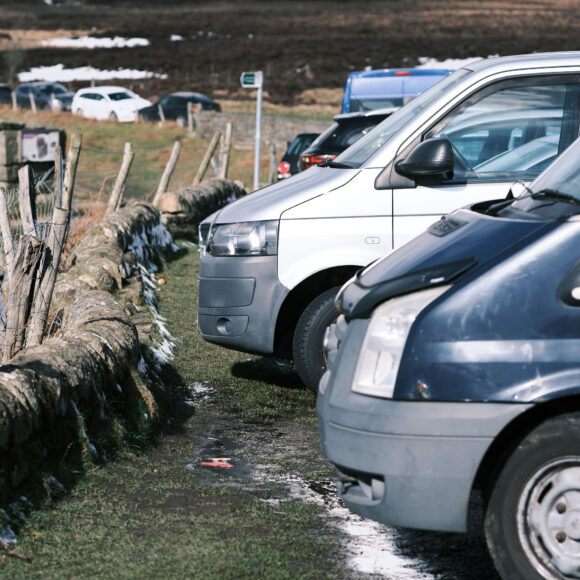

Call Outs
All the above is well and good, but without some kind of peer-enforcement, it’s just empty words. This is the difficult part because none of us really want to spend our leisure time at the crag getting into confrontations with other climbers.
If we start from the assumption that our fellow climbers are not psychopaths out to deliberately trash the rock, then we have to concede that people may genuinely not be aware that, say, climbing on wet rock is damaging.
Most people aren’t out to create a chalky eyesore, set the moors ablaze, or jeopardise access agreements.
Your friend who’s parked slightly blocking a gate might just need a quiet word. The team playing music at the boulders more than likely just don’t appreciate how intrusive other people find it, so an amicable chat is probably preferable to drop-kicking their Bluetooth speakers off into the distance, no matter how tempting (that would count as littering).
The same goes online; a DM or a tactful comment is usually preferable to instigating a pile-on – and social media in particular can be pretty bad for this.
We’re all human, and none of us get it right 100% of the time. If we do find ourselves challenged, we all have to try and not take it personally.
We can take a minute to reflect – how does this look to the bystander? Is there really enough room to park there? Are all these tick marks really necessary? Maybe we would be better off letting this dry out fully and coming back on another day when the conditions are better.
How we respond to the ups and downs in life is, after all, how we grow and develop. Mistakes happen, there’s no shame in that, we just need to be more willing to reflect on our actions when challenged.
But just as poor behaviour can spread, good habits can also spread.
By nature, we take our cues for acceptable behaviour from what we observe others doing. So absolutely the best – and arguably easiest thing – thing we can all do to be champions of responsible outdoor bouldering is simply to set a good example. We’re only shooting ourselves in the foot if we don’t.
Gritstone is a unique feature, but one that needs our protection
Image: Dave Parry
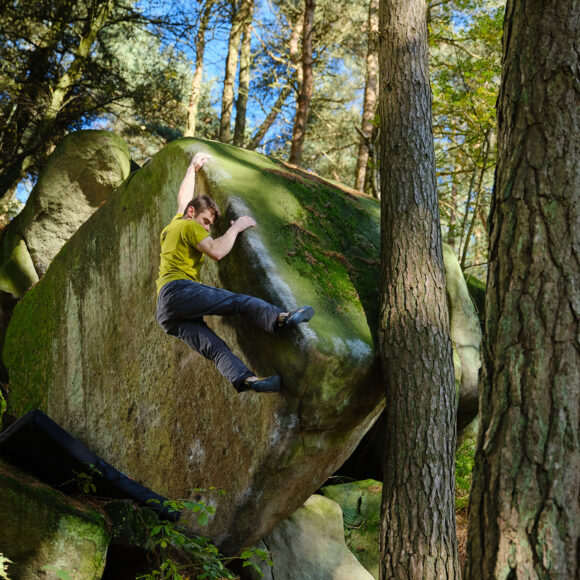

Five Simple Things We Can All Do To Stay Classy
So with this in mind, what simple steps can we all take to ‘Stay Classy’ when climbing outside?
- Look after our crags and boulders – make sure we’re only climbing dry rock
- Use chalk carefully, sparingly, and clean up after ourselves
- Be mindful of our impact on others’ enjoyment of the outdoors
- Share cars, park considerately, or use public transport
- Challenge poor behaviour, and set a good example ourselves
If we keep these in mind we won’t go far wrong; we’ll make sure outdoor bouldering has a sustainable future for everyone.
About the Author
Dave combines his love of climbing and passion for photography to create beautifully curated images of some of the finest climbers on the best lines around.
With over a quarter of a century spent climbing on God’s own stone on the outcrops surrounding his native Sheffield and across the Pennines, Dave feels like he’s almost there on his journey to mastering the art of grit; slopey holds, and trusting marginal feet can be quite an acquired taste, but once you catch the bug, you won’t look back!
All words and imagery are courtesy of Dave Parry on behalf of Depot Climbing.
Pennine Lines

Stay Classy: Responsible Outdoor Bouldering LOCATIONS
Countryside Code
More InformationBMC Regional Access Database
More InformationBMC Access Reps
More InformationUKClimbing Respect the Rock
More InformationDave Parry Website
More InformationPennine Lines
More InformationBest Bouldering Mats
More InformationCategorised in: Community
This post was written by depotadmin
